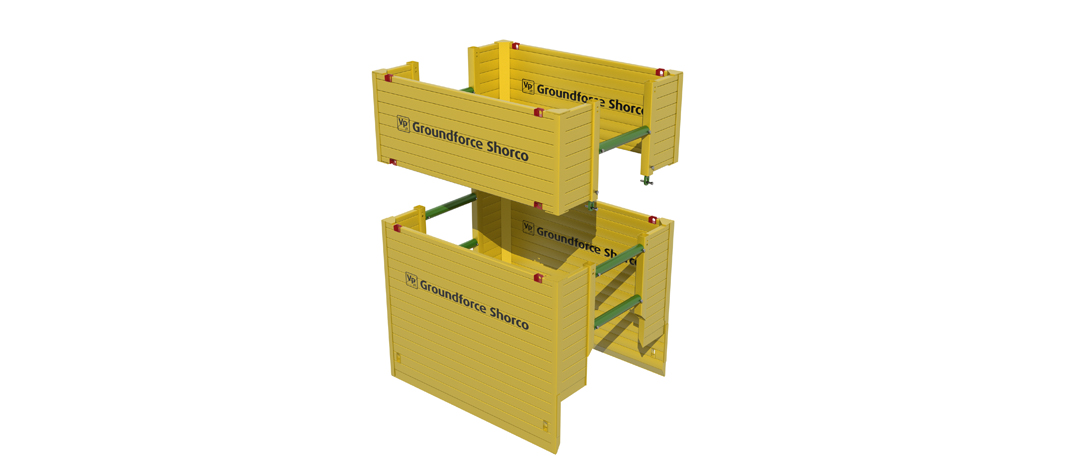Trench Box FAQs

When should a trench box be used?
When you consider that one cubic metre of soil can weigh in excess of 1.5 tonnes, it doesn’t take much to appreciate that any excavation collapse is likely to be catastrophic; resulting in severe injury and worse. Trench boxes however are versatile, cost effective and provide an excellent way of protecting workers from excavation wall collapse while carrying out groundworks.
Trench boxes are generally the first choice for the shoring of trench runs due to the sheer speed and simplicity of assembly and installation. They are suitable for use in trenches up to 5m wide x 6m deep in reasonable ground conditions. Trench Boxes can easily be stacked and used in multiple runs which also makes them the ideal shoring method for continuously supporting an extended length of trench.
How much does a box weigh?
The aggregate weight of a trench box will essentially be determined by the size of panels used together with the type of struts and associated accessories. In conditions where a lightweight solution is required, the Groundforce range of backhoe trench boxes provide an excellent option.
All our user guides provide information on the weights for different configurations of boxes and this is useful to know for transport purposes, but also essential information for the hirer as it dictates the excavator class and capacity required in order to lift or position the box.
Can you stack trench boxes?
Ease of installation, the ability to extend trench runs plus the option of being able to stack trench boxes makes this system one of the most versatile shoring systems on the market.
Depending on the soil pressures acting on the panels, trench box allow for up to two additional top boxes to be stacked on the base box. A simple connection system using a cassette and pin system quickly and easily connects the boxes. Depending on the depth of the excavation, panels can be used as an upstand when a section of panel remains above ground and can be included in the design as a safety feature
How do you install a trench box?
Following the design phase of a groundworks project, a type of trench box may be selected as the approved shoring method. On site, the trench box panels and struts will be safely assembled on the surface prior to setting in the partially dug trench. The trench box can then be installed using the traditional dig and push method, connecting any additional top boxes as the excavation proceeds and finally fitting any edge protection barriers.
How deep can a trench be without shoring?
The Construction (Working Places) Regulations 1966 specified that any excavation exceeding a depth of 1.2m is the point where a shoring system should be in place. This was however deemed to be too specific and restrictive as in many cases this did not account for a range of different ground conditions and other circumstances. Regulation 31 in CDM 2007 (and latterly Regulation 22 in CDM 2015) later stated that ‘all practicable steps shall be taken, where necessary to prevent danger to any person’.
CDM 2015 however also insists that:
- No excavation or part of an excavation collapses
- No material from a side or roof of, or adjacent to, any excavation is dislodged or falls
- No person is buried or trapped in an excavation by material which is dislodged or falls
At what depth do you need trench support?
Previous recommendations specifying an arbitrary 1.2m maximum depth excavation without shoring is now superseded by CDM 2015 and it is now the responsibility of a competent person to establish whether an excavation requires shoring or not, regardless of depth. For example, a very shallow depth could pose a greater risk due to granular soil and other conditions, while on inspection an excavation of deeper than 1.2m could conversely pose a minimal risk.
CDM 2015 however requires that a competent person must inspect the excavation, work equipment and materials:
- At the start of the shift in which the work is to be carried out
- After any event likely to have affected the strength or stability of the excavation
- After any material unintentionally falls or is dislodged
What is the difference between a trench and an excavation?
An excavation is a hole in the ground of any shape or size made by a human after removing earth.
A trench is also classed as an excavation but is more typically where the depth is greater than the width and is a narrow excavation in relation to its length. Trenches are usually associated with the narrow excavations often used by utility companies when installing pipework or power cables etc. In this respect it is worth considering that a trench is actually a type of excavation but has more specific features.